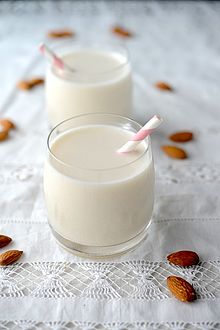**History and Commerce of Almond Milk:**
– Almond milk has been used as a dairy substitute since the Middle Ages.
– Its popularity continued into modern times, with significant growth in sales.
– Almond milk sales in the US increased by 79% in 2011 and surpassed soy milk in 2013.
– In 2014, almond milk accounted for 60% of plant-milk sales and 4.1% of total milk sales in the US.
– Various legal cases in the US and EU have addressed labeling and marketing of plant-based milks.
**Production and Regulations of Almond Milk:**
– The production process involves soaking and grinding almonds in water.
– Commercial almond milk is homogenized and pasteurized for shelf life.
– Homemade almond milk can be stored for 4-5 days in the fridge.
– Almond milk is a protected traditional agricultural product in certain Italian regions.
– Legal disputes, like a 2015 class action lawsuit, have challenged labeling practices of almond milk manufacturers.
**Sustainability and Environmental Impact of Almond Milk:**
– Almond milk has lower greenhouse gas emissions but requires more water to produce than other plant-based milks.
– Concerns exist about the sustainability of almond farming in California due to water usage.
– A glass of almond milk requires roughly 74 liters of water to produce.
– The almond industry has been working on sustainability practices to reduce its environmental footprint.
– Choosing sustainable almond milk brands can help mitigate the environmental impact.
**Health and Nutrition Aspects of Almond Milk:**
– Almond milk is not a suitable replacement for breast milk or cows’ milk for children under two.
– It contains less protein than dairy milk but is low in calories and sugar.
– Almond milk is rich in vitamin E, often fortified with calcium and vitamin D.
– Nutritional differences between almond and cows’ milk, like vitamin A and D fortification, should be considered.
– Excessive consumption of almond milk may lead to weight gain, and those with nut allergies should avoid it.
**Consumer Awareness and Controversies Related to Almond Milk:**
– Some almond milk brands have faced false advertising lawsuits.
– Consumer confusion may arise from labeling and nutritional claims.
– Almond milk’s popularity has led to market competition.
– The rise of vegan and plant-based diets has increased almond milk consumption.
– Understanding almond milk’s nutritional value and environmental impact is crucial for informed consumer choices.
Almond milk is a plant-based milk substitute with a watery texture and nutty flavor manufactured from almonds, although some types or brands are flavored in imitation of cow's milk. It does not contain cholesterol or lactose and is low in saturated fat. Almond milk is often consumed by those who are lactose-intolerant and others, such as vegans, who avoid dairy products. Commercial almond milk comes in sweetened, unsweetened, vanilla and chocolate flavors, and is usually fortified with micronutrients. It can also be made at home using a blender, almonds and water.
 | |||||||
| 15 kcal (63 kJ) | |||||||
| |||||||
Global almond milk sales in 2018 were US$5.8 billion, growing at 14% per year, and forecast to be a $13 billion global market by 2025.
